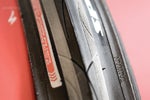New perk! Get after it with local recommendations just for you. Discover nearby events, routes out your door, and hidden gems when you sign up for the Local Running Drop.
The question of tubulars or clinchers has been asked for years, and we don’t expect a universally accepted answer anytime soon. While it’s unlikely the two sides will ever see eye to eye, there are pros and cons to each tire.
For starters, it’s important to know the definitions of clincher and tubular tires. A clincher tire is the most common type of tire. Chances are, when you bought your bike, it came with clincher tires and wheels on it, as tubular tires are generally found only on aftermarket, high-performance wheels.
A clincher tire is one in which the tube is separate from the tire, meaning that when you get a flat you can simply change the tube. The tire itself is almost a U shape and hooks onto the edges of a rim, with a tube placed inside of the tire when mounting it onto a wheel.
A tubular tire, sometimes called a sew-up, has more of an “o” shape, with the tube sewn into the tire, forming one unit. The whole structure is glued onto the rim of the wheel. Once a tubular tire has been punctured, the whole tire needs to be replaced.
There are four main variables to consider when deciding whether to ride tubulars or clinchers: weight, ease of repair, ride quality and rolling resistance. One area where tubulars have a decided advantage is in weight. Both the tire and the rim of a tubular are simpler, mechanically speaking, as these tires do not require beads in the tire and hooks in the rim to hold the tire to the frame. With less material comes less weight. Further, when looking at full-composite rims (e.g. full-carbon rims), there are few choices in a clincher style, with most companies bonding an alloy rim to a carbon structure in order to mount the tire. This of course increases the weight of the wheel as well.
In terms of repairing a flat tire, clinchers have a decided advantage. In most cases you simply remove the old tube from the tire and install a new one. It is only in rare cases, in which the tire suffered significant damage, that you would need to replace the whole tire. A tubular tire, on the other hand, needs to have the whole tire replaced in the case of a flat because the tube is integrated into the tire. Given that the tire is glued to the rim, removing the old tire can be difficult, and a new tire must be glued on. There are now quick-fill sealants for tires that can fix small punctures, and thus prevent you from having to change your tubular, though these systems work just as well on clinchers.
Ride quality is an area where tubulars have taken on an almost mythical quality over the years, and to challenge their supremacy in this area has been viewed as sacrilege. Mechanically, there are two reasons for this. A tubular has a rounder, more uniform shape than a clincher. Also, most of the air volume sits above the rim in a tubular, providing a smoother ride. In addition, many high-quality tubular tires use latex tubes, which are more supple than the butyl tubes normally found in clincher tires. However, with this in mind, clincher tires have become more like tubulars over the years in terms of their construction process, with some clinchers even being referred to as open tubulars. Combining a high-quality clincher tire with a latex tube can provide a ride much like a tubular. This, combined with the inability to quantify a concept such as ride quality, leaves this area of the debate open for years to come.
Rolling resistance is the last variable to consider when comparing clinchers and tubulars. Ask almost anyone which one is better in this regard and the answer will almost undoubtedly be tubulars. This has been a given for years, mostly because of the supple feel that tubulars have, which people have assumed results in lower rolling resistance. But the obvious isn’t always what it seems, and this is one area where a definitive answer can be established with data.
Retired Silicon Valley engineer Al Morrison has spent the last several years testing the rolling resistance of virtually every tire you can imagine, and his work has come to be seen as one of the most comprehensive databases on the subject. Shockingly, in virtually all cases, clincher tires show less rolling resistance than tubulars. What’s more, the rolling resistance of a tubular is highly dependent upon how it’s glued. Even a fast tubular can be slow if it’s not glued properly. Given that a tire that is glued properly as to reduce rolling resistance involves so much glue that removing a tire becomes nearly impossible, the practical implications are significant.
Weighing all of these pros and cons leads to the conclusion that clinchers are the better option for the majority of triathletes. Only those whose primary concern is overall weight or ride quality truly need tubulars. When looking specifically at the use of a tire in triathlon, where rolling resistance and the ability to change a flat are more critical to performance than the other two variables, it would seem that on race day, clinchers reign supreme. Of course, we haven’t even discussed the new generation of tubeless tires and how they factor into all of this, but we’ll get into that in another column.
Christopher Kautz, MA, is the owner and founder of PK Cycling and one of the originators of the fit studio concept. His clients include numerous Ironman world champions, Tour de France veterans and Olympians. You can find him online at Pkcycling.com
